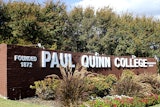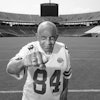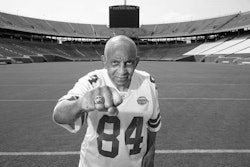Black College Baseball’s Uncertain FutureFacing a dearth of African American talent and a lack of institutional support, HBCU programs seek alternative strategies to field competitive teams. Black college baseball is not what it used to be. And there’s little chance that it will ever be the same again. The glory years, many say, are gone for good. From the late ’60s through the late ’80s, historically Black colleges produced a healthy share of major-league stars such as Hal McRae (Florida A&M), Lou Brock (Southern University), Dennis “Oil Can” Boyd (Jackson State) and Willie Mays-Aiken (South Carolina State). But now, it’s a new day. And the talent pool has dried up significantly.
Black youngsters no longer take up the game at a young age like their fathers and grandfathers before them. Football and basketball are the dominant sports, particularly in America’s inner cities. The small group of elite Black players who do stick to the sport usually sign a major-league contract right out of high school, or they play for one of the nation’s top college powers such as Stanford University or the University of Miami. This trend explains why the percentages of Blacks playing in the major leagues and at the NCAA Division I level are noticeably lower than they were 10 years ago (see accompanying charts).
“Today, kids have a lot more options, so they’re choosing other activities besides baseball,” says Marty Miller, who has coached at Norfolk State University for 30 years. “Because of that, it’s difficult to find a lot of Black players to bring into your program. I’m confident that we’ll still have Black college baseball, but the game as we have known it will be different.”
Compared with their mainstream NCAA Division I counterparts, historically Black schools continue to fight an uphill battle to field competitive teams.
With so few top-caliber Black baseball players to choose from, Black schools have been forced to recruit the best players available, regardless of ethnic background. That’s ironic considering there was a time when Black colleges were the only place Black players could go.
As a result, the face of the Black college game has changed — literally. Historically Black colleges continue to play, but the rosters of many of the teams are no longer predominantly Black. A look at the nation’s two historically Black college sports leagues — the Southwestern Athletic Conference (SWAC) and the Mid-Eastern Athletic Conference (MEAC) — provides ample evidence.
Overall, SWAC schools have been able to attract a sizable number of Black athletes. Except for Mississippi Valley State, the conference schools’ rosters are at least 70 percent Black and only one of the head coaches in the 10-team league is White. “But that’s slowly beginning to change,” says Wilbert Ellis, who has coached at Grambling State University in Louisiana for 42 seasons. “I’m convinced that Black college baseball has a future. But we as coaches will have to make adjustments in our recruiting to help us win more consistently.”
In the MEAC, however, change is already evident — to the extent that the conference has become a baseball melting pot. Of the seven schools that play the sport in an 11-member league, there are just three Black coaches. In addition, there has been a dramatic shift in the racial makeup of MEAC teams. Florida A&M University, one of the storied programs in Black college baseball, is a striking example. This past season, 40 percent of FAMU’s players were either White or Hispanic. Delaware State University has close to a 50-50 racial mix, and a third of the players at four-time MEAC champion Bethune-Cookman College in Florida are Hispanic.
“Coaches are under pressure to win,” explains FAMU’s coach Joseph Durant. “So, the priority is to find those kids who can play Division I baseball, regardless of skin color. On our recruiting list for next year, seven of our top 10 are either White or Hispanic. It’s getting so much harder to find Black players. There’s so much emphasis on basketball. Seems like everybody wants to be like Mike.” Succeeding Against the Odds
As a whole, historically Black colleges have not broken major ground at the Division I level, but the picture is hardly bleak.
Louisiana’s Southern University, the first HBCU to advance in postseason play has held its own. The Jaguars beat California State University-Fullerton in the ’87 NCAA regionals and Northeast Louisiana in ’99 regionals, and they defeated Austin Peay University in the ’96 NCAA play-in game. Southern (45-10 last spring) is considered the creme de la creme of the Black college game, having made five NCAA playoff appearances while winning 11 SWAC championships.
“There’s a lot of pride in this program. That’s why we’ve been able to do the things we’ve done,” says Southern coach Roger Cador, a former Atlanta Braves player who has coached the Jaguars for 18 seasons. “The one thing about baseball that has helped us is that it’s the only sport where White schools aren’t beating down the doors to get the top Black athlete. That’s why we’ve been able to bring in our share.”
Over the last two seasons, Southern players have fared well in the baseball draft. Michael Woods was drafted in the first round by the Detroit Tigers in 2001. Fred Lewis was taken in the second round by the San Francisco Giants in this year’s draft. Rickie Weeks, Southern’s top returning player for next season, could be the best of the three. Weeks, a junior All-American, is playing with the United States team this summer for the World Games. He led the nation in hitting (.495 average) and is viewed as the nation’s best returning player. Weeks is projected as a No. 1 pick for the 2003 draft.
Bethune-Cookman College has the look of an emerging contender in the making. The upstart Wildcats pulled off a couple of surprises this past spring, beating the University of Miami, the 2001 NCAA champ, during the regular season, along with five other teams who made the NCAA playoff field. Bethune-Cookman capped its season with a convincing victory over Florida International in the regionals back in May to pick up its first postseason win in school history.
“The big thing we need now is consistency,” says Bethune-Cookman coach Mervyl Melendez, a Puerto Rican native. “We can’t be one, two, or three-year wonders and expect to get to where we want to be. To be (national) contenders we have to keep bringing in good players and continue to put a good product on the field. As long as we can bring in quality student-athletes, that’s all that really matters.”
Aside from having to deal with a diminishing talent pool, Black college baseball has managed to keep its head above water in spite of the daunting challenges.
Baseball is not a self-sustaining sport at many schools, particularly HBCUs. The game does not come close to matching the revenues provided by football and basketball. As a result, Black-college programs don’t have the resources to consistently compete against many major-
college programs. While some of the HBCUs are still able to attract some of the better players, they fall short in terms of budgets, facilities, equipment and adequate funding for recruiting and paying a full staff of coaches.
“Since baseball doesn’t bring in the money like football and basketball, administrators don’t see baseball as a priority for their athletics programs,” says Glenn Harris, a Washington-based sportscaster who was a catcher on Howard University’s baseball team in the early ’70s. “To compete, there has to be a commitment, and the decision-makers have to understand that baseball at the major-college level is a big-time pursuit. A lot of the stadiums these colleges play in are better than a lot of minor-league ballparks.”budgeting disparities
There’s a wide disparity in budget figures for HBCU baseball programs and their mainstream counterparts. Southern, for example, has a budget of $250,000, which is at the high end for Black schools. Most of that pays for scholarships and coaches’ salaries. The Jaguars recruiting budget from last season was just over $3,000. In the MEAC, Florida A&M’s budget is in the $225,000 range and Bethune-Cookman’s budget is around $195,000.
By comparison, the dollars spent by the national contenders are in a league of their own, and they have managed to generate some healthy income in the process. Louisiana State University, for example, spent $878,318 on baseball this past season, while totaling $1.6 million in revenue. The University of Texas, this year’s NCAA champion, forked out just under $1.3 million for its program and had an income of $750,000. NCAA runner-up South Carolina spent $750,000 and generated $250,000 in ticket sales, according to the individual universities.
In spite of their modest budgets, Southern and Bethune-Cookman have pressed forward. They’re no longer interested in just being competitive. Winning is considered an attainable goal. In their recruiting, both schools stress their high graduation rates (Southern 85 percent; Bethune-Cookman 67 percent), competitive schedules and the fact that they get to play in front of pro scouts all season long.
“It’s been frustrating at times,” says Melendez about recruiting in Florida, a state where the college game is highly competitive and has its loyal following. “We’re going after the best talent, and we’re starting to get results, so recruiting has gone well for us lately. We’re winning some games against good teams, some of our players are getting drafted, so there’s a lot more interest now.”
Southern’s Cador has enjoyed a fair amount of recruiting success, frequently tapping into Chicago and Detroit during the early part of his coaching career. In recent years, Cador has had to move on because of the shrinking talent pool. Now he’s attracting players from Atlanta and Houston, and he has his eye on expanding to the West Coast.
Cador can look seriously at California thanks to Southern’s Web site, which was designed solely for its baseball team. The site, <www.subr.edu/baseball>, has been operational for two years and is believed to be the only one of its kind at a HBCU.
“We feel like this is working in our favor,” Cador says. “The way things are now, kids like to get on the computer, so Southern is there and they can find out a lot about our program.”
the title ix factor
Given Black college baseball’s current state, there are questions about its future. Because of budget limitations and the need to adhere to Title IX, the game could face possible extinction at many schools. Title IX prohibits gender discrimination in athletic programs at all schools that receive federal funding.
Howard University dropped baseball as a varsity sport this past spring. The team had no facilities of its own and was frequently forced to practice at the football stadium or the campus gym, locations that were not suitable for the team to take batting practice. To add to the program’s shortcomings, head coach Jimmy Williams was only part-time and his one assistant was a volunteer. School officials deny that baseball was eliminated because of Title IX considerations.
“This is an issue about the lack of facilities we control to support the (baseball) team,” Howard athletics director Sondra Norell-Thomas told the Washington Post.
“The situation at Howard was very much like a dying person hooked up to a respirator,” says Harris, who was inducted into the Bison’s Hall of Fame in ’96. “You didn’t want to see them in that situation to start with, but once they’re gone, you’re glad that it happened. But in this case, it was a life that could have been saved.”
Prior to Howard’s baseball departure, South Carolina State decided to quit the sport in order to comply with Title IX mandates. The Bulldogs turned in their bats and gloves in 1993 and haven’t played since. With no baseball, the school channeled its resources to fund its women’s softball program.
Harris says the lack of concern about the game from Black college administrators, combined with the shortage of funds could eventually wipe out baseball in the MEAC. “With the exception of Florida A&M and Bethune-Cookman, nobody in the MEAC seems to care about baseball,” Harris contends. “If that continues, those two will be the only teams playing … they’ll wind up competing as independents.”
Norfolk State’s Miller hopes that things never get to that point. But he does acknowledge that HBCU baseball programs will have to find ways to survive. “It’s not so much that administrators aren’t supportive of what we do,” Miller says. “It’s really because baseball is a non-revenue sport trying to hold its own in a climate of tight budgets and Title IX. With those things working against you, it’s tough to fund a program to the extent that it will be competitive. Our administration supports us, but they’re not in position to provide the funds it takes to improve our program.”
The extent to which Black college baseball programs survive will continue to depend on recruiting and their ability to upgrade facilities and generate revenue. Grambling is scheduled to finish construction of its new baseball field in August at a cost of $1.5 million. The furnishings include lights for night games, additional seating, clubhouses for the home and visiting teams, plus a grandstand and concessions area. Southern has planned a $2 million renovation of its home field that’s projected to be completed in 2003.
“Black colleges have to find ways to make baseball into a money-making avenue,” Grambling’s Ellis says. “You do that by building better facilities, which will help the program generate the funds it needs to operate. Once that’s done, you have a better chance to attract some of the best teams. And your own fans will want to come out to those games to see you play against some of the nation’s best teams in your home stadium.”
Durant’s vision for Florida A&M is geared toward developing workable strategies to market his program. In the past, the Rattlers, whose baseball alumni class includes Hal McRae, Vince Coleman, Marquis Grissom and Andre Dawson, has conducted baseball card shows and celebrity golf tournaments as part of their fund-raising campaign. “Our programs have to become more self-supportive, otherwise, we’re going to face even more of a struggle,” Durant says.
© Copyright 2005 by DiverseEducation.com


















